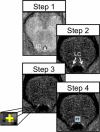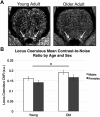Neuromelanin marks the spot: identifying a locus coeruleus biomarker of cognitive reserve in healthy aging
- PMID: 26521135
- PMCID: PMC5134892
- DOI: 10.1016/j.neurobiolaging.2015.09.019
Neuromelanin marks the spot: identifying a locus coeruleus biomarker of cognitive reserve in healthy aging
Abstract
Leading a mentally stimulating life may build up a reserve of neural and mental resources that preserve cognitive abilities in late life. Recent autopsy evidence links neuronal density in the locus coeruleus (LC), the brain's main source of norepinephrine, to slower cognitive decline before death, inspiring the idea that the noradrenergic system is a key component of reserve (Robertson, I. H. 2013. A noradrenergic theory of cognitive reserve: implications for Alzheimer's disease. Neurobiol. Aging. 34, 298-308). Here, we tested this hypothesis using neuromelanin-sensitive magnetic resonance imaging to visualize and measure LC signal intensity in healthy younger and older adults. Established proxies of reserve, including education, occupational attainment, and verbal intelligence, were linearly correlated with LC signal intensity in both age groups. Results indicated that LC signal intensity was significantly higher in older than younger adults and significantly lower in women than in men. Consistent with the LC-reserve hypothesis, both verbal intelligence and a composite reserve score were positively associated with LC signal intensity in older adults. LC signal intensity was also more strongly associated with attentional shifting ability in older adults with lower cognitive reserve. Together these findings link in vivo estimates of LC neuromelanin signal intensity to cognitive reserve in normal aging.
Keywords: Aging; Brain reserve; Cognitive reserve; Gender; Locus coeruleus; Norepinephrine; Sex.
Copyright © 2016 Elsevier Inc. All rights reserved.
Figures




References
-
- Ahissar E, Haidarliu S, Shulz D. Possible involvement of neuromodulatory systems in cortical Hebbian-like plasticity. J. Physiol. Paris. 1996;90:353–360. - PubMed
-
- Alexander GE, Furey ML, Grady CL, Pietrini P, Brady DR, Mentis MJ, Schapiro MB. Association of premorbid intellectual function with cerebral metabolism in Alzheimer's disease: implications for the cognitive reserve hypothesis. Am. J. Psychiatry. 1997;154:165–172. - PubMed
-
- Álvarez-Diduk R, Galano A. Adrenaline and noradrenaline: protectors against oxidative stress or molecular targets? J. Phys. Chem. B. 2015;119:3479–3491. - PubMed
-
- Andel R, Crowe M, Pedersen NL, Mortimer J, Crimmins E, Johansson B, Gatz M. Complexity of work and risk of Alzheimer's disease: a population-based study of Swedish twins. J. Gerontol. Ser. B Psychol. Sci. Soc. Sci. 2005;60:P251–P258. - PubMed
Publication types
MeSH terms
Substances
Grants and funding
LinkOut - more resources
Full Text Sources
Other Literature Sources
Medical

